Gennaro Cuofano's Blog, page 202
June 2, 2020
How Does Discord Make Money? Discord Business Model In A Nutshell
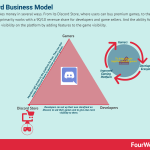
Discord makes money in several ways. From its Discord Store, where users can buy premium games, to the seller shops, that primarily works with a 90/10 revenue share for developers and game sellers. And the ability for sellers to get more visibility on the platform by adding features to the game visibility.
Origin story
One of the first encounters of Jason Citron, with anything close to a gaming console, as he recounted, was the NES (Nintendo Entertainment System) as he played Super Mario Bros. thinking it was the most amazing thing he had ever seen.
A self-taught coder by age 13, he learned to code by developing small games. As he grew he kept playing any sort of video game, from Final Fantasy VI to Earthbound. He spent hours and hours playing video games.
Inspired by his grandfather which ran one of the earliest electrician consultancies in the 1900s, and his father entrepreneurial roots, Jason started to fix computers to earn some money at the age of 13-14, when he would drop by the homes of elder people to explain to them how computers worked, from basic games to chat functionalities.
Until, at 16 he figured he could get paid to write code for their websites, and that became a real side hustle, which Jason brought on for a few years as a solo-business. Yet the transition from solo-business to entrepreneur wasn’t automatic.
The first company as an entrepreneur
Indeed, Jason Citron spent a few years as a game developer, working for other companies. From 2005-2007 he worked as a game programmer for several companies, until in 2007, he turned entrepreneur, by joining and founding YouWeb Inc., an incubator where he had the chance to focus full time on developing games to build a business out of that.
As he worked on developing a new game for YouWeb, that turned into a game called OpenFeint, a combination of role-playing-game and puzzles.
As Jason Citron would later recall, “This all happened in 2007/2008 when the mobile gaming landscape was totally different from how it is now.” In short, suddenly, the iPhone had transformed the gaming experience. Going from dumbphones to smartphones, the iPhone turned those mobile devices into a gaming console.
From game to platform
OpenFeint would transition from a game to a social gaming network. In the meantime, as it launched games like Aurora Feint and Tower Puzzles, the company had over a million players, but none was paying.
Then one day, brainstorming what to do with the technology built around OpenFeint, Jason Citron, and his co-founder, realized how on mobile devices it was still missing a similar mechanism to Xbox Live, which enabled players to interact and play together.
As they realized that they had built this technology as they built the first games, they transitioned OpenFeint into a social gaming platform, which would eventually take off, so much, that it had by 2008, 75 million registered users. As the OpenFeint software development kit was free, the company made money via revenue sharing, mobile storefronts, and game features.
That is how OpenFeint transitioned from games to becoming a social gaming platform, that later on would become successful in China and be acquired, in 2011 by a Japanese gaming company for $104 million in cash plus additional growth capital allocated to further grow OpenFeint.
A cross-platform strategy to thrive, nonetheless Apple as the main competitor
OpenFeint at a certain point thrived, also when Apple launched its own Game Center, as a direct competitor. Yet, OpenFeint used a strategy of working to help developers integrate within Game Center and other mobile gaming platforms (a cross-platform strategy).
Starting over: the failure that brought to Discord
With the money from the OpenFeint acquisition, Jason Citron built a game development studio, Hammer & Chisel, which would launch other Fates Forever, which Citron defined as “one of the first serious MOBAs on the iPad before Vainglory.”
And yet, it never became commercially successful. By 2015, however, thanks to the learnings in developing Fates Forever, Citron and his team had realized that “voice and text chat on mobile hasn’t really advanced over the past decade” and that there wasn’t a “reliable and secure way for teammates to communicate when playing team games.
From there, Discord was built, the rest is history.
Discord mission, vision and core values
“To bring people together around games“ this is how Discord announces its mission, and it further articulates: “Discord’s free voice and text chat is about making it easier for you to spend time with the people you care about, create these memories, and land a headshot or two.”
[image error]Discord in numbers, in 2020.
How does Discord make money?
Back in 2015, when Discord was launched, asked how it was going to make money, Jason Citron replied:
Our plan is to keep the functionality — the core usability — free. So everything you’re using right now will stay free. Voice, text, mobile, all stay free. Almost all the new features will be free. Deep integrations and overlays and slash commands and bots — all free.
And he continued:
Our plan is to sell optional cosmetic things. One example is what Stan just mentioned: TTS features like selling voice packs. Something like the Unreal Tournament announcer packs. Selling themes, sticker packs, fancy elaborate emoji, sound packs, different sound effects, etc, are still up in the air but it’s what we’re planning to do.
Backed by several investors, Discord raised over $200 million from venture capital firms, that go from Benchmark to Tencent which helped the platform experiment with several revenue streams.
Discord Store
By October 2018, Discord launched its store in Beta, giving the possibility to 50,000 users in Canada to purchase premium games:
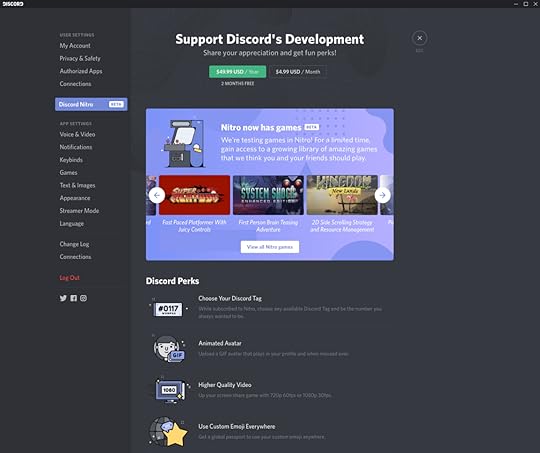 Example of premium features on the Discord store.
Example of premium features on the Discord store.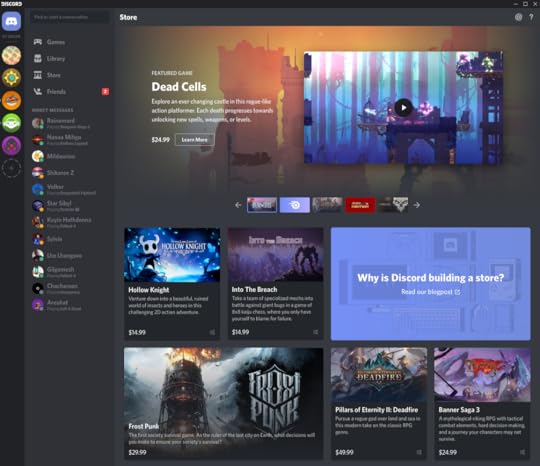 Example of premium games on the Discord store.
Example of premium games on the Discord store.Discord Seller Shops
As of today, sellers can also set up their own store and start selling through Discord:
[image error]
[image error]
Some of the features of the seller shop comprise:
Sell directly to superfans inside the server and customize the storefront.90/10 revenue share on sales.Ability to run private alphas or betas using Discord role-system.
Rich presence: advertising for sellers on the platform
Another monetization mode is that of giving visibility on the platform to game developers through:
Viral Exposure by adding art and detailed information to amplify the game even more. Send Party Invites Messages to amplify the launch of games.Launch Game In A Party that enables you to request an invite right within Discord.Launch Game’s Spectate Mode that adds a spectate button to a player’s profile so any of their friends can watch in one click.
Key takeaways
Using the funds from a previous social gaming platform Jason Citron, launched a game development agency, which developed another unsuccessful game. Yet from that failure, Jason Citron started Discord. Discord is mostly free and backed by venture capital. However, starting in 2018, Discord began to experiment with its premium store to enable users to purchase premium games. Discord also experimented with the seller store, enabling developers to build their game stores on top of Discord and start selling them.Also, Discord also experimented by giving visibility to stores on the platform through a set of paid services to enhance the visibility of the games on the platform.
Read next:
Freemium Business ModelSlack Business ModelYouTube Business modelVenmo Business ModelCraiglist Business modelAmazon Business ModelGoogle Business ModelNetflix Business Model
Handpicked resources:
What Is Business Model InnovationWhat Is a Business ModelBusiness Strategy ExamplesWhat Is Market SegmentationWhat Is a Marketing Strategy
The post How Does Discord Make Money? Discord Business Model In A Nutshell appeared first on FourWeekMBA.
How Does Honey Make Money? Honey Business Model In A Nutshell
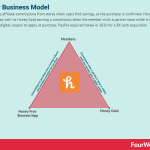
Honey earns affiliate commissions from stores when users find savings, as the purchase is confirmed. Honey also makes money with its Honey Gold earning a commission when the member visits a partner store while it offers members a digital coupon to apply at purchase. PayPal acquired honey in 2020 for a $4 cash acquisition.
Origin story
The founding story of Honey recounts that his co-founder Ryan Hudson, was looking for a Pizza online for his two kids. He was looking for a coupon code, and yet the search wasn’t that smooth.
So he thought, “Why can’t I just automate the process?” As an engineer, that was a normal thought process. As the story goes, as Ryan Hudson put the kids to bed, he then put together a prototype of the Chrome extension to solve this problem.
Ryan Hudson and the other co-founder George Ruan, for over two and a half years, had been looking, unsuccessfully for investors, until money run out. Indeed, Hudson also went back to work as a product manager at an ad tech company. And yet, while he returned on Honey, the extension had been growing organically, through a beta testing group.
Until it leaked over Reddit and it started to gain traction. From there it started to grow rapidly on the Chrome’s store, until it reached over five million downloads by 2017.
[image error]
In 2020, the Honey Chrome extension counted more than 10 million users. This is how a business model was created out of a browser extension.
Honey mission and core values
As reported on the Honey website its mission is to “make the world more fair” as “everyone should have the information they need to make the best decisions with their money.”
As the company explains “We give everyone the tools it takes to find the best savings, perks, and all around value. And we make them free and easy-to-use. So you can always spend with confidence.“
[image error]Honey claimed to have saved more than a billion dollars to its over seventeen million worldwide members and it rewarded them more than $8 millions.
The company’s core values move along seven principles:
Seek the core principles: Meant “digging deep into the root cause of why something is the way it is.” Do the right thing: Explained as “We always prioritize what’s right for members over what’s profitable.”Think Clever: Where data is mixed with imagination to solve members’ problems. The company also claims to always be “scrappy” also as it scales.Build things that make you proud.Make everyone around you better.Own the outcome.Grow without limit: Explained as “…We stretch ourselves to the limits of our abilities until we start to feel uncomfortable. That’s where the magic happens.“
How does Honey work and make money?
The Honey revenue model is organized around earning an affiliate commission from stores when users find savings. As soon as the purchase is confirmed Honey accrues its earnings. Honey also makes money with its Honey Gold where the company earns a commission when the member visits a partner store. While offering its members a digital coupon to apply at purchase in the parters’ stores.
[image error]Honey primarily comprised a set of six tools: Droplist, Savings Finder, Honey Gold, Price History, Amazon Best Price and the Honey Mobile App.
Honey key products comprise:
Savings Finder: Honey’s primary tool was the Droplist which “automatically finds and applies coupon codes on 40,000+ popular sites.”Honey Gold: On top of that the company built the Honey Gold program, which is a cashback card unlocking offers to the stores partnering with Honey. Droplist: an alert system that notifies the user when there is a price drop on the selected items. Price History: This shows “how much an item’s price has gone up and down in the past” thus enabling users to pick the right time to buy.Amazon Best Price: an Amazon comparison app, that looks at the prices applied by several sellers on the platform. Mobile App
How much is Honey worth?
In January 2020, PayPal completed the acquisition of Honey for $4 billion dollars, paid in cash. As PayPal announced, “the addition of Honey to our platform enables a significant step forward in our commitment to provide powerful services and tools for merchants and consumers, move beyond our core checkout proposition and significantly enhance the shopping experience for our 300 million consumers and merchants.”
What made Honey so interesting to PayPal? There are several elements but one in particular. Payment processing companies like PayPal usually intervene in the customer journey only at the end. They don’t have much data or control over the previous journey those people had.
Honey gives the chance to PayPal to have more information about also the deal discovery journey, thus potentially giving it an edge over other payments processing players.
Key takeaways
It started as a browser extension, which in its initial beta didn’t gain enough traction to enable its founders to make a living out of it. Honey also organically grew in the course of over two years, until it leaked on a Reddit post, and it gained viral traction.By 2017, the extension had more than five million users, and by 2020, it counted more than ten million users. Honey makes money from affiliations as members find saving and complete the purchase. And with its Honey Gold program, it also makes money from partners’ stores as they get traffic from members, which in turn gets a digital coupon to spend on those partners’ stores. The company got acquired by PayPal in 2020, for almost $4 billion, in a cash transition, which valued Honey, probably, as one of the most expensive browser extension ever built.Yet PayPal in turn will gain access to the members’ journey in the process of deal discovery, thus giving it more access to the part of the journey where the platform is weaker.
Read next:
PayPal Business modelVenmo Business ModelCraiglist Business modelAmazon Business ModelGoogle Business Model
Handpicked resources:
What Is Business Model InnovationWhat Is a Business ModelBusiness Strategy ExamplesWhat Is Market SegmentationWhat Is a Marketing Strategy
The post How Does Honey Make Money? Honey Business Model In A Nutshell appeared first on FourWeekMBA.
June 1, 2020
How Does Craigslist Make Money? Craigslist Business Model In A Nutshell
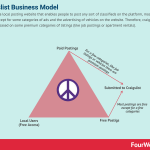
Craiglist is a local posting website that enables people to post any sort of classifieds on the platform, mostly for free, except for some categories of ads and the advertising of vehicles on the website. Therefore, craigslist monetizes based on some premium categories of listings (like job postings or apartment rentals).
Craigslist, the outlier
When you see a website that in 2020 looks like this, and that is still around, that is mesmerizing in its own sake:
[image error]Craigslist’s website layout in 2020.
If you add to it that this website has been and still is among the most popular on earth, it’s backed by a private company, that never got a dime in venture capital funding. Its founder, Craig Newmark, left the company in the hands of another CEO while he stayed for decades in the role of a customer service representative. Yet, this same company might be making anywhere between hundreds of millions to a billion in revenues.
Needless to say, you will want to know how did that even happen.
The origin story: started as a newsletter, turned into one of the most popular sites on earth
After getting to San Francisco, mid ’93, I got lots of help online about getting to know the city.
Early ’95, I figured time to give back, started mailing list for arts and tech events in SF. Grew rapidly via word of mouth. Had to give it a name, and as a very literal nerd, wanted to call it “SF events”, but friends told me they called it “Craig’s List”, that I’d inadvertently created a brand. (Then, they explained what a brand is.)
So, I named it “craigslist”, lower case “c”. The lower case thing is to de-emphasize me. (Capitalizing it is misspelling it.)
Source: Quora
This is how Craig Newmark described the foundation of Craiglist. Where we often hear of companies with a grandiose vision since the start (which is more an apocryphal story than else) Newmark said about his vision for Craiglist, “I prefer to think of myself as lacking vision whatsoever which is a great comfort.”
In an interview for Inc. Newmark explained, how in 1993, “I (Newmark) left IBM and went to Schwab in 1993, and it had a brown-bag-luncheon series where I went around the company saying, “Here’s the internet. It’s going to be how we do business someday.”
Craigslist was launched as an email that went out to 10-12 people related to an event “Joe’s Digital Diner” where those people would discuss emerging technologies. As more and more people asked to be added to the Newmark newsletter, he started to cover arts and technology events first and later featuring “post about a job or something for sale.”
The newsletter then transitioned into a website that by 1997 had over a million page views, yet by 1998, Newmark was still running the site on his own, helped by a few volunteers. Only in 1999, Newmark left the company he was working on, he moved full-time to Craiglist and turned it into a company.
Did Craiglist get funding?
[image error]Source: Quora
At the question on Quora, Craig Newmark, also highlighted, “In 1999, I decided to keep the site almost all free and to walk away from the money bankers and VCs told me was on the table. Not altruism, I’m a nerd, and look at things differently.” In another answer he defined himself “NOT altruistic, it’s dysfunctional.”
Newmark and his obsession for customer support
In starting craigslist, way back in ‘95, I assumed a direct customer support mission.
That put me in direct contact with thousands of people, mostly Americans, who needed basics, like help putting food on the table, getting that table, getting a roof to put the table under.
Direct customer service like that means getting in touch and staying in touch with regular people in a way that I, as an old-school nerd, never did.
I also learned to ignore trolls, if possible; they thrive on attention.
Source: Quora
Newmark is, for sure, an atypical personality, also for the Silicon Valley scene. After leaving the role of CEO, he also left the management for good. Differently to what usually happens to founders pretending to leave the company just to control it from the outside, Newmark instead has stayed for over twenty years in a customer support role.
Is Craig Newmark still at Craiglist?
Overall, I’ve delegated myself into uselessness; I still do just enough customer service to stay in touch with the needs of regular people.
Source: Quora
This was back in 2016, now Craig Newmark is primarily focused on his philanthropic foundation. To understand how active Newmark has been on Craiglist, when a user asked on Quora, back in 2016, how to unblock a company that had been blocked on Quora, Newmark replied “Please email specifics to craig@craigslist.org. I’ll share the request with the team. Thanks!”
That, nonetheless he had left management since 2000.
The fear of the founder syndrome
We associate most of the successful companies today with their founders. Founders haven’t’ just remained primary owners of their organizations, but perhaps also the ones who run it in the most important role, that of CEO. And yet, Craig Newmark fearing the “founder’s syndrome” or the tendency of founders to keep enormous power, after the initial success of the company, he left management roles by 2000, and he only stayed as a customer service representative.
Craiglist bootstrapping way
I wrote all the code in the first few years and used an ISP which provided a web programming platform for maybe thirty bucks per month.
Source: Quora
Craigslist, in the early years just grew through word-of-mouth, and it transitioned from newsletter to website, and only in 2008, as a multi-lingual website. Craigslist’s pace is so slow that when you look at the website layout it barely seems changed over the years. It seems a website left behind the 2000s and yet it’s still a successful website.
This is at the core of its philosophy to keep it simple, straightforward, and to avoid fanciness at all costs.
Craigslist served as traction for Airbnb
As the story goes, in 2007, Brian Chesky and Joe Gebbia couldn’t afford the rent on their San Francisco apartment that is why they decided to transform their loft in a lodging space.
Yet instead of relying on Craiglist, they built their site, which they called Airbed & Breakfast and leveraged on Craigslist to drive users back to their website,
[image error]
This would serve an important growth channel to the initial growth of Airbnb, a company that would later be worth billions.
The eBay acquisition
Craigslist challenged many of the existing giants of the initial web age. As a successful website and marketplace, with a format, mostly free, companies like eBay were challenged by Craigslist. So what’s the best way to avoid losing the battle? One way is to acquire a competitor. That is what eBay set to do back in 2004.
When it acquired a 25% stake in the company, by one of the private shareholders of Craigslist (the company has never been listed), eBay was trying to make up for its inability to build a thriving classifieds section on its marketplace, as reported by NYTimes back in 2004.
This first acquisition was just an attempt by eBay to purchase Craigslist. But the take over never happened. Instead, by 2008, eBay would sue Craigslist claiming a “dilutive action” where, as reported at the time by , Newmark, together with the CEO had tried to reduce the ownership stake of eBay from the 25% to 10%.
Eventually, by 2015, eBay would sell back its stake to Craigslist, which had become over 28%. Apparently, as reported by Forbes, it had bought it from the then-disgruntled shareholder Phillip Knowlton for $16 million, while both Craig Newmark and chief executive Jim Buckmaster had received $8 million. eBay eventually admitted it was trying “to buy the whole thing” but it never happened.
Was Craigslist all about its “personals”?
Craigslists has built a name over the years also thanks to its friendly attitude toward “calsual encounters” on the website. Indeed, its section called “personals” has been among the most popular on the site. As it enabled people to find dating partners esly, and they could also post and advertise photos of themselves.
Craigslist shut it down as it announced it at the time:
US Congress recently passed HR 1865, “FOSTA”, seeking to subject websites to criminal and civil liability when third parties (users) misuse online personals unlawfully.
Any tool or service can be misused. We can’t take such risk without jeopardizing all our other services, so we have regretfully taken craigslist personals offline. Hopefully we can bring them back some day.
To the millions of spouses, partners, and couples who met through craigslist, we wish you every happiness!
How does Craigslist make money?
Most of Craigslist postings are free, except for certain postings, like advertising of vehicles on the website.
As highlighted on Craigslist website “all craigslist postings are free, except for:
Job postings in US and selected CA areas—$10-75 (fee varies by area) Apartment rentals in Boston, Chicago, and NYC areas—$5 Commercial real estate in the US—$5 All for sale by-dealer categories in the US—$3-5 Cars/trucks by-dealer in the US, Vancouver BC—$5 Furniture by-dealer in Vancouver BC—$3 Cars/trucks, RVs, and motorcycles by-owner in the US—$5 Gigs in US and selected CA areas—$3-10 Services in US and CA—$5″
Craigslist digital distribution explained
[image error]Craigslists key website metrics as of May 2020, according to SimilarWeb estimate.
As of 2020, Craigslist still seems to have a strong digital presence, mostly built n its brand:
[image error]Craigslist marketing mix according to SimilarWeb.
Indeed, most of the traffic on the platform is direct, therefore people skip search engines to reach the platform directly.
[image error]Craigslist interest over the years, according to Google Trends.
Over the years, at least in the US, interest on the brand and website has decreased, yet still strong.
[image error]The strength of the Craigslists brand given by the local value of its listings.
This strength is primarily driven by the local listings, as people across the world use Craigslist locally, to list their stuff for free. And the fact that most of the listings are free, and its wide traffic, surely makes its value proposition still compelling.
[image error]The audience overlap of Craigslist according to Alexa.
Key takeaways
Craigslist is such an unconventional story, that it leaves us with many open questions about how to build a successful business without following any of the conventional rules that apply to the business world.
Listen to what your audience is saying. In Craigslist case, that is about simplicity, functionality and to avoid fanciness at all costs (you only need to look at its website to understand what that means).Are you the person better suited to grow your company? If not, can you choose a person that can do it for you? In an era where most companies impersonate with their legendary founders, there is no simple answer. When “enough is enough”? Can you build a valuable company that still generates substantial revenues, and yet you keep it how at your own pace and terms?
According to the Craigslist story, you can do all the above. There is a caveat though. Craigslist could have become any of the Amazon, Facebook, or Google of our days. Companies worth trillions and with a deep global reach, and able to dominate the industries of the future. And perhaps some of you reading this might think it’s good it didn’t turn like that.
Instead, it remained what it was, a local listing website, where here and there you might hear stories of its former popular “casual dating section.”
Read next:
Open-Source Business ModelMozilla Business ModelFastly Business ModelWikipedia Business ModelWordPress Business Model
Handpicked resources:
What Is Business Model InnovationWhat Is a Business ModelBusiness Strategy ExamplesWhat Is Market SegmentationWhat Is a Marketing Strategy
The post How Does Craigslist Make Money? Craigslist Business Model In A Nutshell appeared first on FourWeekMBA.
May 31, 2020
How Does WordPress Make Money? WordPress Business Model
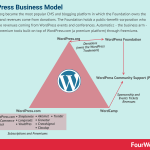
WordPress.org became the most popular CMS and blogging platform in which the Foundation owns the trademark, and revenues come from donations. The Foundation holds a public-benefit-corporation who manages the revenues coming from WordPress events and conferences. Automaticc – the business arm – monetizes premium tools built on top of WordPress.com (a premium platform) through freemiums.
Origin story
In 2003, Matt Mullenweg (at that time 19) after a summer camp, had taken photos he wanted to share online. There were already blogging platforms like Blogger (from Google), MovableType, and others. Matt thought why not developing a whole new blogging platform.
He picked b2, as it was the only open-sourced, yet almost abandoned project. Jut back then, what would later become his co-founder Mike Little, left a comment to the Mullenweg’s article talking about the blogging platform, which gave rise to the project that would bring to WordPress.
They forked the code (copied the source and started to develop independently on top of it) and started the development of what would later become WordPress, it was the beginning of 2003 and by May they were ready to launch WordPress:
[image error]Matt Mullenweg, announced WordPress was ready Back in May 2003, in his blog (source ma.tt)
The initial growth of WordPress wasn’t without obstacles. Indeed, as WordPress was growing it also had to deal with with spam, and indeed Akismet (a software to prevent spamming on a blog) was among the first tools developed on top of WordPress (it was 2005), and on top of that Matt Mullenweg built its company, Automattic.
By 2005, Matt Mullenweg explained why he finally moved full time on WordPress:
It was just about a year ago I blogged about leaving Houston and driving across the country to join CNET. It ended up being one of the best moves of my life. Since moving to the Bay Area I’ve had incredible oppurtunities and met a whole tribe of amazing people. For what I’m passionate about, I really believe this is the best place in the world to be.
…I was wondering if I could focus on my passions full-time, to put more daytime hours into the community and projects that have changed my life already. I don’t need much, and working on WordPress full-time is my idea of heaven. I gave notice (they’ve been incredibly supportive).
I could say this was a hard decision, but the truth is I can’t imagine myself doing anything else.
By 2005, WordPress would grow even further, and it started to strike important partnerships. It also got featured on Yahoo Hosting services. As Matt Mullenweg left CNET and moved full time to WordPress, he also constituted Automattic, the company that would manage all the tools built on top of WordPress.
In 2006, WordPress was still a third player, as Google’s Blogger and Technorati were dominating.
Matt Mullenweg would “praise its third place” as he mentioned in his blog, back then: “[A] study of the performance of twenty major American companies over four decades found that the ones putting more emphasis on market share than on profit ended up with lower returns on investment; of the six companies that defined their goal exclusively as market share, four eventually went out of business.”
By the end of 2006, Blogger would take over Technorati, to become the most popular platform that year.
In the meantime, WordPress would also evolved substantially from 2003 to 2008:
 Source planetozh.com
Source planetozh.com Source planetozh.com
Source planetozh.comIn the meantime, by 2004, the first plugins (applications) started to be developed on top of WordPress, thus fostering the development community. In 2005, the WordPress repository would be officially launched, and it snowballed. In a few years, thousands of plugins would be developed.
By 2009 WordPress would further take off until it became the most popular world’s CMS (content management system).
[image error] Source: w3techs
WordPress.org vs. WordPress.com
To understand how the whole WordPress business model is organized, both in terms of the development community and business ecosystem, it’s important to distinguish between WordPress.org, the open-source CMS – that became the most popular blogging platform on the internet; and WordPress.com, a set of hosting and software services, often packaged under a single subscription plan.
Therefore, WordPress.org is the open-source service managed by the WordPress Foundation. While WordPress.com is the hosting service and the set of premium features built on top of WordPress.com, and it’s managed by the business arm that Matt Mullenweg created, Automattic.
In addition, the WordPress community has grown over the years through official events run by WordPress (known as WordCamp) and local meetups. As the WordCamp has grown into a large event non-profit organization, the WordPress Foundation has moved the management of the sponsorships for these events into a subsidiary “WordPress Community Support.”
Therefore, to recap this is how the whole WordPress business model works:
WordPress Foundation: which runs on top of donations.WordPress.com run by the business arm, Automaticc, which has a set of products, mostly based on subscription revenues or freemium offerings.And WordCamps events managed by the Foundation’s subsidiary WordPress Community Support, run as a Public-benefit corporation, which collects the revenues coming from events.
WordPress.org and the WordPress Foundation
The WordPress Foundation is a charitable organization that Matt Mullenweg founded, which mission, with its main open-source project, WordPress.org is “to democratize publishing through Open Source.”
The WordPress.org foundation runs through donations. For instance, inf 2018, the revenues which, as reported on the WordPress foundation website, “$13,296, with donations making up $11,178 of this amount.”
The WordPress trademark is owned by the Foundation.
WordPress.com family and the business arm, Automatic
[image error]The freemium offering of WordPress.com, built on top of WordPress.org, comprises a set of additional products part of the WordPress.com family (Akismet, Jetpack, WooCommerce, and others). The free product offers a fast set up of WordPress as a CMS. However, it doesn’t comprise plugins and premium themes. Most of WordPress.com products run on a freemium offering.
Automattic was constituted back in 2005, when Matt Mullenweg moved full-time to WordPress. Automattic is the company behind products like:
WordPress.com. WooCommerce.Jetpack.Simplenote.Longreads.VaultPress. Akismet.Gravatar. Crowdsignal.Cloudup.Tumblr.
A distributed company that reported 1186 employees in 2020. In the last round, in 2019, as the company got a $300 million funding round in Series D from Salesforce Ventures (the investment arm of Salesforce), the company got valued over $3 billion.
The primary products of the company all run on a subscription revenue model, and they are mostly freemiums.
WordCamps, the WordPress Community Support as a Public-benefit corporation
[image error]The WordCamp is the official WordPress set of events and conferences. They run both locally and globally. The WordCamp conferences put together the whole WordPress community made of developers, and hundreds of companies that through plugins and themes have built successful businesses on top of WordPress CMS.
WordPress Community Support is organized as a public-benefit corporation (or a corporation which has a wider social scope).
The company collects sponsorship and ticket revenue. Therefore, WordPress decided to manage independently the trademark from the financials of the events organizations and WordCamps.
To have some context, the total revenue in 2018, for the WordPress Community Support, was $4,631,214 comprised of:
Sponsorship Income: $3,796,677 (81.9% of total revenue)Ticket Sales $831,022 (17.9% of total revenue)
[image error]The events expenses (WordCamp and local meetups) incurred by the WordPress Community Support benefit-corporation. Source: WordPress Foundation Blog
The WordPress ecosystem: plugins and themes
[image error]An example of the flywheel that gave rise to the WordPress entrepreneurial ecosystem, at the foundation of the success of WordPress, also as a open-source project. Open-source projects that do not find an economic model might get abandoned over time. WordPress instead, built a solid economic foundation to enable the growth of its community over the years.
As any successful digital platform, WordPress grew as a result of the community and entrepreneurial ecosystem born on top of it. To have a bit of context, in WordPress a plugin is an application, that without coding, allows users to do any sort of things (just like your iPhone apps enable you to enhance your smartphone in all sorts of ways).
The place where all the plugins are kept and published in the WordPress.org Repository (the equivalent of an AppStore in WordPress). And it was announced for the first time in 2005:
We are proud to announce wp-plugins.org, the WordPress Plugin repository. A need was felt for a set of common tools, and a common playground for developers creating plugins and themes to extend WordPress.
The WordPress repository has two key players:
Developers: who can develop, make visible, and manage the codes for their plugins.Users: who can browse and download any sort of plugin, and in addition give feedback to them.
By September 2007, there would be 1,021 active plugins for a total of 1,597,994 downloads. The whole WordPress ecosystem was taking off!
In May 2020, there were over 56,550 plugins available on WordPress.org. Popular plugins, like Yoast SEO, counted by May 2020, almost 250 million downloads, with over five million active installations. A company built on top of a WordPress plugin, which, in 2019, generated $12 million in revenues.
Thus, the whole success of WordPress came, as it enabled an entire ecosystem of developers to build valuable tools for users, which made the platform to scale, with limited costs. As a result, a whole entrepreneurial ecosystem formed.
Key takeaways
Born from the idea of its founder to build an open blogging platform, based on a previous blogging open-source project (b2), WordPress’s founders forked it (it means they copied the source code of b2 and started to develop on top of it independently) and built WordPress.org.WordPress.org is among the most popular blogging platforms, and it has been organized around a Foundation (who owns the trademark), which generates marginal revenues via donations ($13K in 2018). A Public-benefit corporation, managing the revenues coming from the official WordPress events. And a business arm, Automaticc, the company founded by Matt Mullenweg in 2005, to maintain the set of software products built on top of WordPress.com. WordPress grew rapidly as an open-source project, and it further took off as it enabled the development of an entrepreneurial ecosystem made of plugins and themes that have been one of the key of the business success of WordPress over the years.Its revenue generation varies based on the setup. The Foundation runs on donations; the Public-benefit corporation runs on collecting sponsorship and ticket revenues. And Automaticc, runs mostly by subscriptions and freemium products.
Read next:
Open-Source Business ModelMozilla Business ModelFastly Business ModelWikipedia Business Model
Handpicked resources:
What Is Business Model InnovationWhat Is a Business ModelWhat Is Business StrategyWhat Is Market SegmentationWhat Is a Marketing Strategy
The post How Does WordPress Make Money? WordPress Business Model appeared first on FourWeekMBA.
May 30, 2020
How Does Wikipedia Make Money? Wikipedia Business Model

Wikipedia is sustained by the Wikimedia Foundation, which is supported mostly by donations and contributions, which in 2018 amounted to almost $98 million. Wikipedia is among the most popular websites on earth, and it is, as of these days, an open, non-profit project, on which other twelve projects have been developed.
Wikipedia origin story
Back in 2001, Jimmy Wales and Larry Sanger stumbled on the idea of having an encyclopedia, rather than to be edited centrally, could instead be built by hundreds of contributors. Initially, the project was called Nupedia.
However, it later changed the name to Wikipedia, to recall the Hawaiian term “wiki” which stands for “quick” or “super-fast” – “wiki wiki.”
A few years before, Jimmy Wales had retired from his options trading career, and having made some money, he had started another website called Bomis, which would aggregate erotic photographs materials. While Bomis would eventually close, from its resources, Nupedia was created. Thus, bringing to life Wikipedia.
Today Wikipedia is among the most popular sites on earth and for sure the most known encyclopedia.
Wikimedia family
[image error]
The Wikimedia Foundation is the non-profit that hosts Wikipedia and other free knowledge projects brought on by the Wikimedia family. The Foundation was established as a nonprofit in 2003.
In 2012, asked how he decided the best way to go, Jimmy Wales said: “Thinking about how do we sustain it? How do we make this work? Putting it into a non-profit (referring to Wikipedia) seemed a reasonable way to go.”
13 projects are part of this family and are dvided in five main categories:
Reference.Collections.Technology.Guides.Collaboration.
Reference
Wikipedia “All the world’s knowledge” the encyclopedia written in 300 languages.Wikibooks or a collection of free e-book resources including textbooks, annotated texts, instructional guides, and manuals.Wiktionary a dictionary for over 170 languages.Wikiquote an online collection of sourced quotations.
Collections
Wikimedia Commons, the world’s largest free-to-use library of illustrations, photos, drawings, videos, and music.Wikisource, a library of freely-licensed source texts and historical documents.Wikiversity, learning resources, learning projects, and research for use in all levels, types, and styles of education.Wikispecies, a database for taxonomy that covers living and fossil representatives of Animalia, Plantae, Fungi, Bacteria, Archaea, Protista, and all other forms of life.
Technology
Wikidata, central storage of structured data for Wikimedia projects. MediaWiki is free and open-source wiki software that anyone can use and develop. The platform on which Wikimedia projects are built.
Guides
Wikivoyage which aim is to provide the world’s largest free, complete and up-to-date worldwide travel guide.Wikinews, a free content alternative to commercial news sites with articles that are fact-checked and peer-reviewed.
Collaboration
Meta-WikiProject is a project used as a central hub for various coordination and organization tasks.
How does Wikimedia spend money?
[image error]Source: Wikimedia Foundation
The Wikimedia foundation expenses comprise four main categories:
Direct support to websites: servers + ongoing engineering improvements, product development, design and research, and legal support. Direct support to communities through grants, programs, events, training, partnerships, tools to augment contributor capacity, and support for the legal defense of editors.Fundraising.Administration and governance with 350+ staff and contractors to support a wide variety of projects.
How does Wikimedia make money?
As Jimmy Wales, himself explained: “As a business, it’s a pretty terrible, It exists based on donations.”
[image error]
Read next:
Open-Source Business ModelMozilla Business Model Fastly Business Model
Handpicked resources:
What Is Business Model InnovationWhat Is a Business ModelWhat Is Business StrategyWhat Is Market SegmentationWhat Is a Marketing Strategy
The post How Does Wikipedia Make Money? Wikipedia Business Model appeared first on FourWeekMBA.
E-Commerce Business Models In A Nutshell
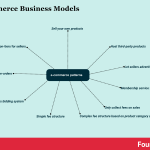
We can classify e-commerce businesses in several ways. General classifications look at three primary categories:
B2B or business-to-business, where therefore a business sells to another company.B2C or business-to-consumer, where a business sells to a final consumer.C2C or consumer-to-consume, or more peer-to-peer where consumers sell to each other.
Rather than getting bogged down in too many classifications, we’ll very practically look at the revenue streams of several successful e-commerce businesses, and see if we can borrow any of those elements and apply them back to our e-commerce business model.
Amazon hybrid model
[image error]Amazon has a diversified business model. In 2019 Amazon posted over $280 billion in revenues and over $11.5 billion in net profits. Online stores contributed to over 50% of Amazon revenues, followed by Physical Stores, Amazon AWS, Subscription Services, Third-party Seller Services, and Advertising revenues.
What can we learn from Amazon? Amazon is an interesting example, as it had the time to evolve over two decades. So from Amazon, we can get what worked and see if that might work in building up our own e-commerce platform.
Amazon e-commerce, is structured around few lines, that make it solid:
Sell your own products to kick off the e-commerce
You might not know, but Amazon also sells a wide variety of brands that are owned by Amazon. Therefore, over the years, the company internalized some of the successful products on the platform so it could gain better control over sourcing and perhaps customer experience.
Therefore, if you’re kicking off e-commerce, think of some simple products you can develop and start to sell to kick off the platform. And from there expand on third-party products
Host other physical stores that need a digital presence
In addition to that, Amazon hosts a wide variety of third-party products. Therefore, Amazon is an e-commerce platform, hosting other small e-commerce brands.
Here it’s important to offer a great hosting platform that works out well, and it’s smooth. And from there, you can build other revenue streams.
Transaction-based: Most of Amazon‘s earnings as e-commerce is based on getting a commission on the transaction happening on the platform.
At the same time, Amazon also offers some related services. Thus, once the e-commerce has been kicked off, you can start offering some related services.
Build services on top of your e-commerce
Over the years, Amazon developed its fulfillment part, which comprises an inventory of products for third-party sellers, and shipping. When third-party e-commerce jin into Amazon fulfillment services, they don’t have any more inventory and delivery expenses, as they outsource them to Amazon.
However, they give up a good chunk of revenues, as Amazon will collect more from. the transaction. When kicking off the e-commerce platform, and you have a critical mass of sellers, think of all the ways you can make their life easier (analytical tools, shipping tools, and so forth).
This will make them stick longer, and perhaps also create an additional revenue stream for your business.
Build membership services to abate shipping costs for customers
Building up also a related subscription-based service, on top of e-commerce, can be a great idea, to increase repeat customers, by making it more convenient to shop on e-commerce, by, for instance, abating the shipping costs.
That is what Amazon achieved with Prime, by offering a playlist of movies and entertainment (similar to Netflix).
You don’t have to go that far. All you need to do is to create a membership program, that gives access to special discounts and perhaps free delivery (we’ll see how Walmart has successfully implemented that).
Offer premium listings, or paid visibility
Once you do have kicked off the e-commerce you can also have it, in part subsidized, by other businesses selling their products. For instance, you can sell more visibility on e-commerce just like Amazon does. Indeed, Amazon e-commerce also has a successful advertising line, that enables better product placement and visibility.
eBay complex fee-based model
[image error]eBay core business is a platform business model that makes money from transaction fees happening through its marketplaces (eBay and StubHub). eBay also makes money through advertising on its classifieds marketplace and other services. The company primarily makes money by charging fees on successfully closed transactions.
eBay is also a great example, as the company makes money primarily through fees collected on successfully closed sales on eBay and StubHub. In addition to that, eBay also built a classified ads platform and a few other seller services.
eBay is a classic example of an e-commerce platform, that enables people to sell any sorts of things. The company has a compelling value proposition, which the company expresses in:
Easy listing, with a quick and simple set up.Free listing, as sellers, can have up to 50 items for free every month, and only pay when they sell.
In addition, eBay counts over 170 million buyers and a stable and secure platform.
[image error]
eBay collects fees in four ways:
Insertion fees as an entry-point
As explained on eBay:
When you list and sell items on eBay, we charge selling fees. There are two main types of selling fees: an insertion fee when you create a listing, and a final value fee when your item sells.
Therefore, the seller has 50 free per month products to feature, and beyond that, the fee for listing in mostly $0.35, but it can vary.
Final value fees to make it compelling to selers to join
In final value fees, the e-commerce platform only makes money if the transaction is closed. On the eBay case, those fees can be 10% or lower.
Listing upgrades as additional option
[image error]
With optional upgrades like international site visibility, larger photos, bold character, more space to images, and more, listing upgrades can be a great option for sellers and a good way for the e-commerce platform also to subsidize it.
Fees in selected categories and based on selling-volume
Fees are different for certain categories and depending on whether the seller is a low or high volume. Therefore, eBay has a more complex fee structure, built over the years, also based on its experience.
[image error]Example of fees for high-volume sellers, based on the vehicle category (eBay seller website).
[image error]Example of low-volume sales fees based on the vehicle category (eBay seller website).
[image error]Example of optional listing (eBay seller website).
Etsy simple fee model
[image error]Etsy is a two-sided marketplace for unique and creative goods. As a marketplace, it makes money via transaction fees on the items sold on the platform. Etsy’s key partner is comprised of sellers providing unique listings, and a wide organic reach across several marketing channels.
Etsy is an incredible example of a two-sided e-commerce platform, also called a marketplace, as it enables smooth interactions between creative and buyers.
[image error]
[image error]
Etsy has a solid mechanism of category-suggestion when sellers are entering their items on the platform.
Etsy also has a very simple fee structure:
[image error]
Etsy made its fee structure straightforward, and broken down in:
Listing fee.Transaction and payment processing fee.Offsite ads fee (only. for those who opt-in to Etsy offsite advertising program).
Etsy also offers seller tools to make their presence on the platform more valuable:
[image error]Seller tools are key elements of e-commerce platforms built to host third-party sellers.
GrubHub bidding system
[image error]Grubhub is an online and mobile platform for restaurant pick-up and delivery orders. In 2018 the company connected 95,000 takeout restaurants in over 1,700 U.S. cities and London. The Grubhub portfolio of brands like Seamless, LevelUp, Eat24, AllMenus, MenuPages, andTapingo. The company makes money primarily by charging restaurants a pre-order commission and it generates revenues when diners place an order on its platform. Also, it charges restaurants that use Grubhub delivery services and when diners pay for those services.
GrubHub has an interesting business model, comprised of several brands. There are a couple of things worth exploring for GrubHub:
The pre-order commissions charged to restaurants as soon as diners place an order on the platform. Therefore, the company generates revenues primarily when diners place an order; this commission is born by restaurants.Bidding revenues: restaurants can choose their level of commission rate, at or above the base rate. A restaurant that pays a higher rate will have a higher prominence and exposure to diners on the platform.
Shopify subscription-based service
[image error]Shopify is an e-commerce platform enabling merchants to commercialize their products via a monthly subscription fee, and additional services provided by the platform. Its core business is subscription-based, even though in 2018, the company made over 50% of its revenues from another stream called merchant solutions.
Shopify is an e-commerce platform, that hosts other sellers’ websites. As such, it has a very simple pricing structure, made of three tiers:
[image error]
Those pricing tiers are made of a few key elements:
Store’s features: store features comprise things like product uploads, support, SSL certificates, professional reports, and more.
[image error]
Shipping: it comprises discounts which are higher for those with the more advanced plans.
[image error]
Payment: fraud analysis, credit card rates that decrease with higher-priced packages.
[image error]
Read more:
Amazon Business ModeleBay Business ModelEtsy Business modelGrubHub Business ModelShopify Business Model
Handpicked resources:
What Is Business Model InnovationWhat Is a Business ModelWhat Is Business StrategyWhat Is Market SegmentationWhat Is a Marketing Strategy
The post E-Commerce Business Models In A Nutshell appeared first on FourWeekMBA.
May 29, 2020
Open-Source Vs. Freemium: Open-Source Business Model In A Nutshell
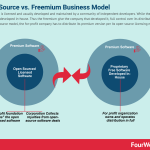
Open source is licensed and usually developed and maintained by a community of independent developers. While the freemium is developed in-house. Thus the freemium give the company that developed it, full control over its distribution. In an open-source model, the for-profit company has to distribute its premium version per its open-source licensing model.
Open-source origin story
The “open source” started by the end of the1990s as a software licensing model, where the code is made available to anyone to change, or perhaps distribute under the open source license. While open source itself is not a business model, but a software licensing model, it has given rise to the whole industry of companies in which business models have been built on top of it, which we will call open-source business models.
But if the open source is free and open, how does it get monetized?
Mozilla Open-Source Model
The way companies build a business model around an open-source can vary widely. Usually, the open-source software is held by a foundation, which is a non-profit company. In Mozilla’s case, the foundation is the one owning the open-licensed browser. The Mozilla Corporation instead collects the royalties coming from the deals built on top of the open-licensed software.
For instance, in 2018, the Mozilla Corporation generated $435.702 million from royalties mostly coming from a deal with Google, featured as a default search engine on Mozilla.
[image error]The 94% of Mozilla Corporation’s revenue comes from royalties earned through Firefox web browser search partnerships and distribution deals. According to StatCounter back in 2008 Mozilla Firefox controlled over 26% of the browser market. Today, due to the market dominance of Google Chrome and Safari, Mozilla has a 5% market share.
Read: Mozilla Business Model
Slack Freemium Model
[image error]
Slack follows a freemium model, where a free version is developed in-house. Thus the software is closed and proprietary. The company, which is a for profit holds the right to distribute the software and therefore doesn’t have any constraints in its pricing and distribution strategy.
Free users are converted in paying customers if they want more usage or advanced functionalities. Slack combines the free model with a direct sales force to acquire enterprise customers with yearly recurring revenue of over 100K. Those customers were 575 in 2019, and they accounted for 40% of its revenues.
Read: Slack Business Model
The post Open-Source Vs. Freemium: Open-Source Business Model In A Nutshell appeared first on FourWeekMBA.
The Family Business Models That Became Empires
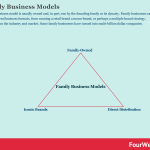
A family business model is usually owned and, in part, run by the founding family or its dynasty. Family businesses can take on several business formats, from running a retail brand a mono-brand, or perhaps a multiple brand strategy, depending on the industry and market. Some family businesses have turned into multi-billion dollar companies.
Brunello Cucinelli Human Enterprise
[image error]
Brunello Cucinelli is an Italian luxury and casual-chic brand, which built its success around cashmere clothing. Brunello Cucinelli built its business around the Humanistic Enterprise model, which revolves around Italian Craftsmanship, Sustainable Growth, and Exclusive Positioning and Distribution. More than 50% of the company revenues come from the retail mono-brand, directly managed by the company.
[image error]
Brunello Cucinelli follows three key distribution strategies:
Retail monobrand where the company controls the direct distribution of stores to the end customer. Those are run and operated by Brunello Cucinelli.The wholesale monobrand channel is made of monobrand stores operated under commercial distribution agreements. The wholesale multibrand channel, consisting of independent multibrand stores and dedicated spaces within department stores (shop-in-shops).
Luxottica Vertical-Integration
[image error]
Luxottica has built its whole success based on integrating the whole supply chain, thus connecting its sourcing and manufacturing process, wholesale capability and retail stores to reach the final consumers.
[image error]
LVMH Multi-Brand Strategy
[image error]
LVMH is a global luxury empire with over €46 billion in revenues for 2018 spanning across several industries: wines and spirits, fashion and leather goods, perfumes and cosmetics, watched and jewelry, and selective retailing. It comprises brands like Louis Vuitton, Christian Dior Couture, Fendi, Loro Piana, and many others.
LVMH follows a multi-brand integrated strategy, where each brand is managed independently. This enables each brand part of the group to keep its identity, while still keeping the advantage of economies of scale, deriving from the fact those brands belong to the holding group.
Prada Iconic Business Model
[image error]
The family-owned Italian luxury brand, Prada generated over three billion euros in revenues for 2017. Europe represented almost forty percent of the total revenues. Among Prada brands, Prada made more than eighty percent of the company’s revenues, followed by Miu Miu, with more than fifteen percent, Church’s which generated two and a half percent of its total revenues. Instead, Marchesi 1824 (a luxury bakery) and Car Shoe (a shoe company) made about half a percent of the total revenues.
Among its products line leather goods represented more than fifty-six percent of the total Prada revenues. Followed by Footwear and Clothing. More than eighty percent of Prada revenues got generated via its directly operated stores. Miuccia Prada owns sixty-five percent of Prada Holding, while Patrizio Bertelli owns thirty-five percent. Prada holding owns eighty-percent of Prada.
[image error]
Prada kept a tight ownership structure where the company is mostly in the hands of the family.
Kering Multi-Brand Group Strategy
[image error]
Kering Group follows a multi-brand business model strategy (very similar to LVMH), where the central holding helps the brands and Houses part of its portfolio to leverage on economies of scale while creating synergies among them.
At the same time, those brands are run independently. This multi-brand strategy comprises brands like Gucci, Bottega Veneta, Saint Laurent, and Puma.
The two primary operating segments based on luxury and sport & lifestyle.
[image error]
Walmart Empire Business Model
[image error]
With over $495 in net sales as of January 2018, and over $4.5 billion coming from Membership and other income.
The company operates three primary units that in 2018 comprise Walmart U.S. (approximately 64% of our net sales), Walmart International (about 24% of net sales), and Sam’s Club (approximately 12% of its net sales) a membership-only warehouse clubs and operates in 44 states in the U.S. and in Puerto Rico, as well as eCommerce.
[image error]
Walmart’s Mission can be summarized as “helping people around the world save money and live better – anytime and anywhere – in retail stores and through eCommerce.” While its vision is to “make every day easier for busy families.” Walmart defines “busy families” as the bull’s eye of its business strategy.
Key takeaways
Family business models, just like other companies can take several forms that help them scale and yet keep the business successful. Some of the examples we saw, you can have a deeper look below:
Successful Business ModelsBrunello Cucinelli Business ModelLVMH Business ModelLuxottica Business ModelPrada Business ModelKering Business ModelWalmart Business Model
The post The Family Business Models That Became Empires appeared first on FourWeekMBA.
The Rise Of The Super Gatekeepers
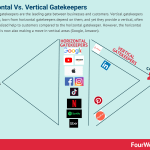
In the digital era, digital platforms made more options available to consumers. Where previously, companies had locked in distribution, thus working primarily on optimizing the supply chain. The first digital platforms formed as a result of an Internet that found its commercial applications in enabling a smoother flow of information, which freed the consumer in terms of choices and options they could make.
Those platforms grew they also locked-in part of the distribution, they still build incredible products, as they’ve been used to grow in an environment of demand-side optimization, where the whole company success would be built around creating mass-adopted products. Those companies became modern gatekeepers:
[image error]In a world driven by tech giants that locked-in the digital distribution pipelines to reach billions of people across the globe, the gatekeeper hypothesis states that small businesses will need to pass through those nodes to reach key customers. Thus, those gatekeepers become the enablers (or perhaps deterrent) for small businesses across the globe.
In the previous era, many markets were fragmented, as the many gatekeepers acted at the end of the chain, by providing few if little value, thus throttling the market. Modern gatekeepers instead, have killed the hundreds of millions of existing gatekeepers (depending on the market) and have unlocked those markets, thus making them explode and hyper grow.
Therefore, in the modern era, a single gatekeeper won it all. Yet, while in the past the gatekeeper captured value by getting a cut on the transaction (or perhaps by making most of the margins on the transaction), the modern gatekeeper can make money by getting a small cut or fee (platforms) or subsidize the whole value chain by a key player (aggregators). This was the first phase.
In a second phase, Horizontal gatekeepers (those able to serve several markets) consolidated, thus becoming the main gate between businesses and customers (Google, Amazon, Facebook, Apple).
In a third phase, vertical gatekeepers also formed. Those were, in part, born from horizontal gatekeepers, as these were not able to cover at the best vertical areas (think of travel search engines like Booking, TripAdvisor, Airbnb were born on top of Google‘s inability to cover at the best vertical areas). Those vertical gatekeepers also depend on horizontal gatekeepers. And yet they provide a vertical, often more specialized help to customers compared to the horizontal gatekeeper. However, the horizontal gatekeeper is now also making a move in vertical areas (Google, Amazon).
In a fourth phase, horizontal gatekeepers are claiming some space back, to recapture market value that before was left to vertical gatekeepers. As horizontal gatekeepers like Amazon and Google, for instance, grew into giants, they also started to cover more and more vertical areas, thus competing directly with vertical gatekeepers.
Is this the fifth phase of super gatekeepers? As those horizontal gatekeepers take more space, they can cover both horizontal and vertical areas, with more specific products to cover them. If this phase consolidates, then we’ll see the rise of super gatekeepers, able to recapture and claim back pieces of the markets they created, that once were handed to vertical gatekeepers.
Read next:
What Is Business Model InnovationWhat Is a Business ModelWhat Is Business StrategyWhat Is Market SegmentationWhat Is a Marketing Strategy
The post The Rise Of The Super Gatekeepers appeared first on FourWeekMBA.
May 28, 2020
A Glance At WeTennis App Business Model

About once a month, I’m hosting on FourWeekMBA, ideas from entrepreneurs, part of the community, which I found exciting and with great potential. As a full disclaimer, I don’t earn anything from this, nor anything is paid to get featured. So if you have a great idea and a business model, let us know.
This time is the turn of Cameron Almas, co-founder of WeTennis. When I went through WeTennis pitch it was clear to me the passion of Cameron for this project, as he has been for over ten years, also a Tennis player, so he well understood the pain points of finding a good partner to play tennis with, and that is where it all started!
Overview of WeTennis
WeTennis is an upcoming startup based in the UK. It aims to provide a 100% free mobile app centered around community and driven by a love for tennis. The value the app provides to users is the ability to find a local player with a similar level of ability to play tennis with.
Finding a tennis partner is not particularly a new problem to solve in the tennis market, yet not many have been able to find a sustainable business model…until now. Generating multiple streams of revenue by year four, the company aims to generate over £30 million in its fifth year of release before looking to be acquired.
What is WeTennis all about?
[image error]
WeTennis wants to give people the best tennis experience possible as it aims to help more people, play more tennis, more often. It believes the best way to do this is through the community. Like most things in life, tennis is best experienced within a local community who share the same love for the sport as you. Therefore WeTennis provides an engaged local community of passionate tennis players worldwide.
What does the app do?
[image error]
As the heart of the app it’s about users finding others in their area to play tennis with. Therefore the app will allow users to search for local players of a similar ability and message them in order to organise a match.
The upcoming app will be built with a community focus so users can also discover local tennis activity and share tennis content.
Who does WeTennis attract?
WeTennis aims to solve the problem every amateur tennis player faces; the ability to find someone in their area and on their level to play with. Therefore no matter if you’re a club player or park player or even university player WeTennis provides a level playing field for players to find someone to play with.
Furthermore, WeTennis has noticed a latent demand of tennis players – these are people who would love to play tennis but don’t because they don’t have anyone to play with. By discovering those in your area that play tennis, WeTennis also aims to also attract such latent demand of players.
How does WeTennis generate revenue if the app is 100% free?
Many have tried and failed to attach a sustainable revenue model to such a product offering. Often predecessors have attached a freemium model or a subscription model, attempting to generate income by making tennis more accessible. However WeTennis will be 100% free off charge upon release and forever more, therefore it aims to generate it’s income via the lifestyle habits all tennis players possess.
The WeTennis revenue model adopts the more old school revenue model of a Razor and Blade model. In doing so WeTennis aims to generate three streams of revenue by its fourth year of trading, and is forecasted to generate revenues of over £30million in its fifth year of trading.
Do you want to know more?
For any comments, questions or concerns feel free to email the founder of WeTennis, Cameron Almas at Cameron@WeTennis.app or visit www.wetennis.app or follow them on Instagram @WeTennisApp.
Relevant resources:
Business Models GuideHow Do Apps Make Money?Digital Business Models
The post A Glance At WeTennis App Business Model appeared first on FourWeekMBA.



